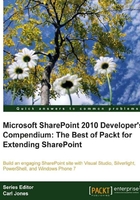
Chapter 2. Building an Engaging Community Site
Organizations today are looking for ways to increase collaboration and to provide more self-help resources through the use of tools like SharePoint. While it can be fairly easy to build a department level collaboration site, it can be significantly harder to build a cross-functional community site not tied to one specific department. This chapter will attempt to highlight those challenges so that you can build a community site that can keep people engaged and bring the collaboration levels that everyone is looking for.
Community sites can be used to drive collaboration and self-help around a specific topic or system. Examples could include business topics like Lean, Six Sigma, or other Process Improvement methodologies, or for system support for various ERP, HRIS, or IT systems. The management, education, and governance of SharePoint itself make for a good community site focus, and will be the focus of this chapter. Using this as a template though, there could be numerous community sites created for an organization.
The community sites can provide a much better collaboration platform, and also can provide user training and a help platform as well. When done properly, people throughout the organization will be willing participants and can help provide that support which better utilizes the company's resources and potentially provide more relevant information. Community sites should be the future of collaboration and perhaps for IT system support.
It is essential to start this process by defining what the goals for the site are, followed by defining the information architecture, content, and feature strategy.
Most community sites have varying levels of formality to the content. On the informal side it could be completely informal collaboration using tools like a note board, a threaded discussion list, perhaps a list of helpful links. Moving more towards the formal side you may also see Frequently Asked Question type lists or system and process documentation. As the community fills with content, it becomes more important to start highlighting popular or useful content.
The return on investment and value offered by community sites are tied directly to the level of user engagement and adoption. Therefore it is extremely important to consider this when designing the site, its features and content. One way to do that is to find community advocates or champions to help lead the cause and generate content. The great thing about this is that communities can grow significantly quicker with a bottom up, grassroots approach. Another thing to consider is to offer incentives to participate or even better, to build it into the job description and duties for various permissions Using the example of a IT System Support site, consider having a help desk person post content or answer discussion questions instead of just answering the phone. Chances are they can assist many more people in a given day, and those answers could continue to benefit the organization for months or years to come. I have come across organizations that will hold contents or offer incentives like premium parking spots, extra days off, or various items of swag as incentives for participation.
This chapter will provide an overview of configuration steps needed to create a base community site template along with example customizations that can be created to provide dynamic and relevant content which is a key ingredient to building an engaging community site solution. The covered solutions include:
- Enterprise Wikis
- Content Rollups
- Community Leaders Group
- Social Web Parts
